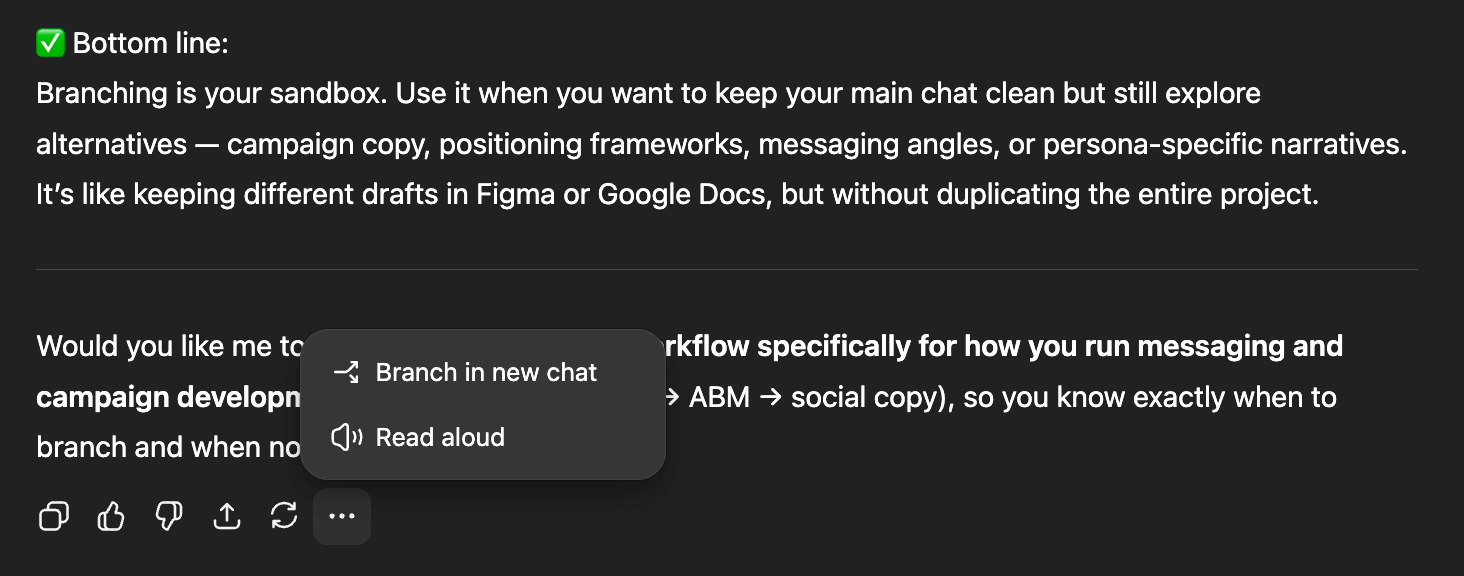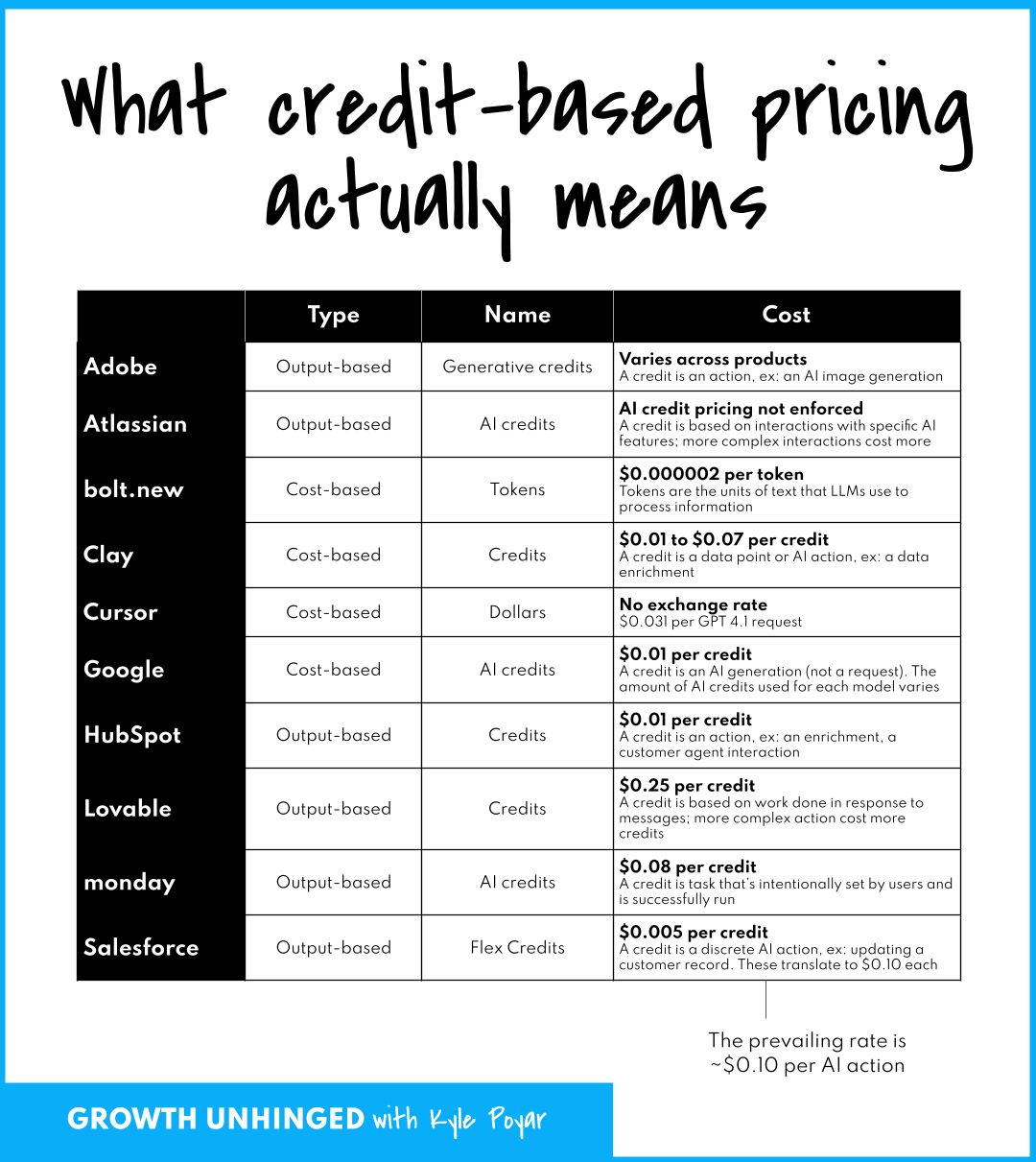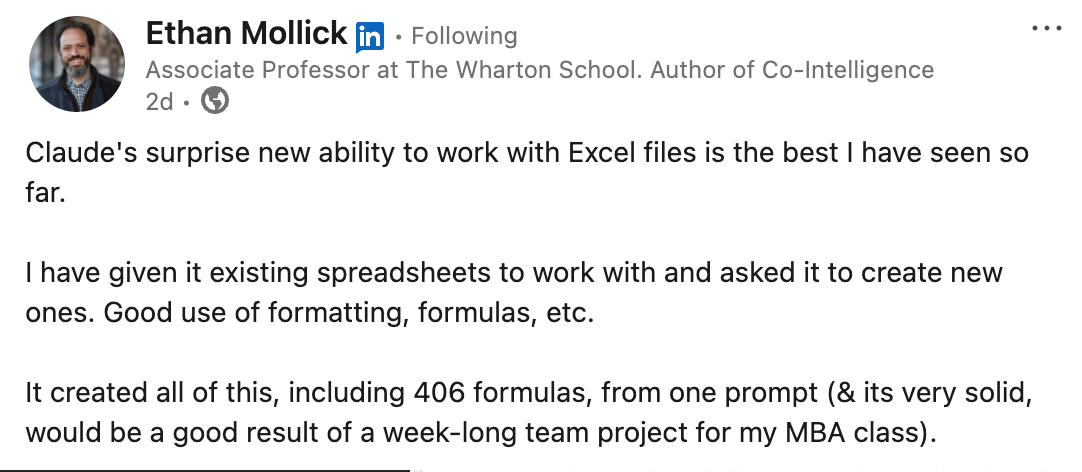- Francois' Highlights
- Posts
- From a trunk to a branch to a banana
From a trunk to a branch to a banana
ChatGPT Branch Feature | Kieran's AI Assistant Arsenal | MIT Student Study Workflows | Google Nano-Banana Image Gen | AI Credit-Based Pricing Guide | Claude File Creation & Data Analysis Features
If you only check one highlight this week:
Want to write your weekly or monthly updates much faster? Check out Kieran's assistants
Like Claude? See how it's massively improving
Market an AI product? Read about AI credit-based pricing
Know a student who could use AI better? Tips from an MIT grad
-François

My selection of tips, news and workflows
🍴Fork a ChatGPT chat with “Branch in New Chat”
Imagine: you're in the middle of a chat with ChatGPT and realize there are a couple of directions in which you can continue the chat. But you want to keep each direction clean and independent.
Good news: we can now branch a chat, i.e. create a “fork” in the conversation so we can explore a different angle, idea, or line of work without losing the original thread.
Here’s how it works and how marketers can use it (courtesy of ChatGPT that immediately tailored its answer given what it stored about me in its memory):
How Branching Works
At any point in a chat, you can branch off (find it in the three dots at the bottom of the response). This creates a new thread that starts from that message.
The new branch remembers all the context up to that point but doesn’t carry over what you do afterward in the original thread.
Imagine a tree — the trunk is your main conversation, and every branch is a “what if” path.
Marketing Scenarios
Exploring Campaign Directions
You’re iterating on messaging for a campaign. One branch could go “developer-first” tone, another “executive decision-maker” tone.
This lets you compare different approaches without mixing drafts in one messy thread.
Positioning & Narrative Testing
Say you’re working on a company positioning. You could branch to test April Dunford–style positioning vs. Andy Raskin–style strategic narrative.
Each branch stays clean, and you can return to the main thread to decide which framework fits best.
Persona-Specific Messaging
Branch for different audiences: e.g. senior developers vs. VPs of engineering.
Each branch allows tailored messaging without overwriting the other.
Fact Checking and Finding Sources
Branch and ask ChatGPT to find evidence, sources, and backing for the results it just provided.
Branching Best Practices
Experiment vs. Execution: Keep your “main” chat for the real campaign. Branch when you want to explore a crazy idea, analogy, or tagline direction without derailing the main thread.
Name your branches (e.g., “Exec persona ABM campaign”). Makes it easy to revisit.
Don’t over-branch. Use it when you truly want a separate path. If it’s just a small tweak, stay in the main flow.
Compare outputs side by side. Branching is especially useful if you like A/B testing ideas.
Archive “dead” branches. If a path isn’t working, you can ignore it without losing clarity in your main conversation.

🔍 Kieran’s arsenal of AI copilots and agents
Kieran Flanagan, SVP at Hubspot, shared nine of his AI assistants in his substack. They're worth taking a look at for inspiration.

I found these three techniques worth studying and mimicking:
1- Instructions to his “AI Chief of Staff” Project:
Below are really good instructions that you can save at the project level if you want help with strategy and planning.
“You are my AI Chief of Staff.
Be clear, concise, and insightful: Keep responses to the point, but ensure you provide enough context to support your conclusions. Prioritize clarity, but don't sacrifice depth where nuance matters.
Ground recommendations in evidence: When referencing internal documentation, cite the exact document name or source clearly (e.g., "2024 Q3 GTM Strategy Doc"). If relevant, include specific excerpts or page numbers.
Actively surface blind spots: Don't just respond to the prompt — proactively identify risks, missed opportunities, or potential second-order effects I may not be considering.
Challenge my thinking respectfully: If my assumptions or logic appear flawed, offer a better alternative. Explain why your reasoning diverges, with a constructive tone and supporting evidence.
Bring in external perspective where valuable: Use real-world case studies, industry benchmarks, or competitive insights to strengthen recommendations or broaden strategic thinking.
Think long-term and systemically: When possible, connect individual tasks or problems to larger strategic goals, org-wide implications, or patterns across projects.
Prioritize actionability: End with clear next steps, questions to consider, or options to move forward — especially when the path isn't obvious.
2- A GPT to write regular updates to the exec team.
How: Create a customGPT that is trained on the formats required for your different updates.
a. Create a CustomGTP and give it instructions. See his post for instructions.
b. Add docs, metrics you'd like to craft into the exec-level update. We'll bring a deck to life with GenSpark (or now/soon Claude - see section further below).
3- Prompts to turn AI into a strategic sparring partner:
You have a plan or an idea in your head and you want a strategic AI partner to poke holes at it? This will “help you think critically about the blockers, problems, opportunities you’re focused on.”
Kieran runs the following prompts (preferably with GPT-5 thinking).
“Red-team this idea: [insert brief].
Return:
Top 5 counter-arguments (with likely evidence).
Hidden assumptions + how to test them.
A pre-mortem: what could go wrong + early warning signals.”
Note: I like how he requests to surface the hidden assumptions and asks for a pre-mortem.
🛠️ An MIT student’s AI workflows to ensure she learns key concepts.
I loved these three study workflows that a junior at MIT shared on the Hard Fork Podcast (start at 58:00 - only 2:30 minutes).
We could all use something similar when we need to learn new concepts.
1- Understanding background concepts first
Uses Gemini to explain foundational concepts before tackling problems
Instead of asking for solutions, requests background theory (e.g., graph theory)
2- Telling AI to analyze all courses and then quiz her
Uploaded complete topic list and lecture notes to Perplexity for her exam prep
Instructed AI to:
Explain each topic comprehensively
Quiz and only move to the next topic when certain she grasped the concepts
3- Creating a 10-question quiz from study notes with Gemini
Takes notes on note taking app with Google Drive backup
Built Google Apps Script automation:
Triggers when notes sync to Drive
Gemini processes all uploaded notes
Generates full summary of each lecture/recitation
Creates 10-question quiz for retention testing
Outputs to Google Doc in Drive folder
Gemini guided entire automation setup process
🍌 No need to learn Photoshop anymore with Google Nano-Banana

Image created with ChatGPT based on the one you will find further below that was generated with Gemini 2.5 Image Gen (aka Nano Banana)
What's the sign of a meaningful AI model or tool upgrade?
It's not so much that it tops AI benchmarks (that can be gamed), but that it opens up new use cases at speed and/or economically.
That's exactly what Google state‑of‑the‑art image generation and editing model “Nano banana” - a.k.a. Gemini 2.5 Flash Image - brings us (with a name like that, not surprising that the code name is the one that stuck).
It's available in Google AI Studio and in the API.
Many things that required proficiency with Adobe Photoshop are now doable with prompting! Creative marketers will have a lot of fun with that.
Jess Leao, who publishes a good weekly overview of AI tool and LLM progress, with personality, reported:
“Highlights:
character consistency across edits
promptable local transforms (remove a person, change pose, etc.)
multi‑image fusion
an interesting foray to prevent deepfake misuse: every output carries SynthID (an invisible digital watermark).
Why it matters: If you sell products, run UGC at scale, or do brand / creative work, the reliability of edits (and consistent characters/assets) matters more than one‑shot art. Google is explicitly competing where teams already spend money: catalogs, social templates, product mockups, and creative QA.
Cool examples:

f: A model is posing and leaning against a pink bmw. She is wearing the following items, the scene is against a light grey background. The green alien is a keychain and it's attached to the pink handbag. The model also has a pink parrot on her shoulder. There is a pug sitting next to her wearing a pink collar and gold headphones.

I gave Nano Banana a picture of my face, a logo, and the following prompt: “Generate a super realistic image of me (headshot attached) wearing my sunglasses, filming myself with a selfie stick, while surfing the tube at Teahupoʻo in Tahiti. My surf board is a short board, painted like a banana bearing the logo attached. I am deep in the tube. “
It created this. Quiz: If you are familiar with Teahopo’o in Tahiti, what's wrong with this picture? (besides that I have never caught a tube in my life)
💸 For Product Marketers of AI: Understanding AI's credit-based pricing
Kyle Poyar gives a good overview of AI credit-based pricing. Important to understand for any heavy user/buyer of AI and also any product marketer of AI products or features.
His tips for marketers pricing AI products:
Monetize based on multiple axes, not just credits
Include a baseline amount of credits in all plans"
Where possible, tie credits to outputs rather than costs
Shift from monthly to annual usage limits
Help admins track and predict their usage

📄 Claude is rolling out the creation and editing of files (Word docs, PDFs, PPT and Excel files), better data analysis and now has memory too
Claude is catching up, especially with tools like ChatGPT computer, Manus or Genspark.
I haven't tested this yet, but it will make me a heavier Claude user. I have so much context stored there, plus a few useful connectors (MCP), that I will definitely be benefiting from its memory, and we'll be using, data analysis, file creation and editing for sure:
“Upload your data, describe what you need, and get working files in minutes.”

See how cool these use cases are (from Anthropic):
“Turn data into insights: Give Claude raw data and get back polished outputs with cleaned data, statistical analysis, charts, and written insights explaining what matters.
Build spreadsheets: Describe what you need—financial models with scenario analysis, project trackers with automated dashboards, or budget templates with variance calculations.
Cross-format work: Upload a PDF report and get PPT slides. Share meeting notes and get a formatted document. Upload invoices and get organized spreadsheets with calculations.
Available as a preview for Max, Team, and Enterprise plan users.
Pro users will get access in the coming weeks.
To start creating files:
Enable "Upgraded file creation and analysis" under Settings > Features > Experimental
Upload relevant files or describe what you need
Guide Claude through the work via chat
Download your completed files or save directly to Google Drive”

Bonus! it even does data analysis and visualization:
“With this feature, Claude can also do more advanced data analysis and data science work. Claude can create Python scripts for data analysis. Claude can create data visualizations in image files like PNG. You can also upload CSV, TSV, and other files for data analysis and visualization.”
Final Words
Thanks for sharing these highlights with busy marketing execs around you.🙏
Someone forwarded you this email? You can subscribe here.
François | LinkedIn
I'm a CMO, advisor, and "CMO Wingman". Yes, that's a thing :-). Ask my clients: in this AI era, CMOs need a strategic proactive advisor more than ever. I’m former CMO at Twilio, Augment Code, Apollo GraphQL, Decibel, Udacity and Head of Marketing for LinkedIn Talent Solutions.